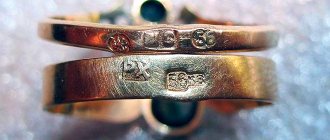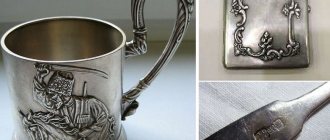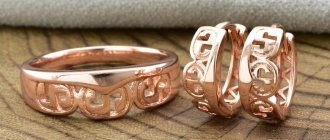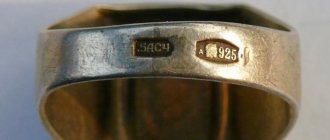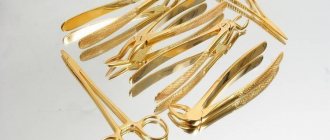Often there is a need to purify gold from other metals contained in the alloy or scrap. When obtaining gold by cyanidation, dissolving ore in a solution of potassium cyanide, gold is also often mixed with silver and copper in the final product.
If it is necessary to turn low-grade gold into high-grade gold, the same task arises - to clean the precious metal from accompanying impurities. A classic method that allows for fairly simple cleaning is dissolving gold in aqua regia.
History of research and use
Fox - an alchemical image of aqua regia in an engraving from the “Book of Twelve Keys” by Vasily Valentin, Musaeum Hermeticum
, 1678
Long before the discovery of hydrochloric acid, Latin texts attributed to the Arab-Persian alchemist Geber (Jabir ibn Hayyan) (8th century) described a method for obtaining aqua regia by dry distillation of a mixture of saltpeter, copper sulfate, alum and ammonia in a glass, well-sealed vessel, equipped with glass lid or cap.
In the writings of Albertus Magnus it is called aqua secunda
(“secondary vodka”, and “primary vodka” -
aqua prima
- nitric acid), among other alchemists -
aqua regia
.
In 1270, Bonaventure pointed out his own method of producing ammonia by dissolving ammonia in “strong vodka” ( aqua fortis
, nitric acid).
Bonaventure also found that nitric acid dissolves silver, separating it from gold; Using aqua regia, he established its ability to dissolve the “king of metals” - gold, which until some time was considered impervious to change. Thus the name aqua regia
(also
aqua regis, AR
) appeared. The alchemical symbol for aqua regia was made up of the water sign
and the capital letter R. Aqua regia was later described by Pseudo-Geber, an unknown alchemist whose treatises began to spread in Europe in the 14th century.
The preparation of aqua regia by mixing concentrated hydrochloric and nitric acids was first described in Alchemy by Andreas Libavius (1597). Establishing the fact of dissolving noble metals in aqua regia was considered by alchemists as a solution to one of the most important problems of alchemy: the preparation of alkahest - a universal solvent. The use of aqua regia in alchemical practice led to a significant increase in knowledge about substances and chemical reactions and contributed to the development of assay analysis and technical chemistry.
In Lavoisier’s works, aqua regia was called “nitromuric acid,” in accordance with the idea that the gas released (chlorine) was nothing more than the oxide of the element muria, dephlogisticated hydrochloric acid.
In Russia
In Russia it was called royal vodka (M. V. Lomonosov, 1742), royal vodka (M. Parpua, 1796), saltpeter-hydrochloric acid (V. V. Petrov, 1801), nitric hydrochloric acid (G I. Hess, 1831); Other names are also known. The word “vodka” originally appeared in the Russian language around the 13th-14th centuries as a diminutive of the word “water” and had this primary meaning until the middle of the 19th century. The strong alcoholic drink, now called vodka, was then called “bread wine,” “hot wine,” “green wine,” and so on. The word “vodka” acquired the meaning of “alcoholic drink” somewhere between the 14th and 19th centuries, initially as a dialect, and only at the end of the 19th - beginning of the 20th century began to mean only “strong alcoholic drink.”
How to make your own aqua regia
To prepare aqua regia, combine 3 parts hydrochloric acid with 1 part nitric acid. It is necessary to mix the components only before use, since during storage, volatile products evaporate, reducing the activity of the solvent.
Dissolution of gold is also possible in hydrochloric acid, but the reaction rate is low. Nitrogen acts as a reaction catalyst. Therefore, you should first pour HCl into a glass container and place gold-containing objects in it. And only now gradually add nitrogen.
It is important not to overfill the nitrogen, as this will complicate the process of Au precipitation from the solution.
Gold refining is
To obtain gold by refining, and this can be any gold-containing enriched rock, gold contacts, radio components, and so on. There is a mandatory stage of preparation for processing, mainly grinding the rock or radio components, removing unnecessary excess materials. Next, everything is fired and subjected to chemical reactions. Also, sometimes gold-containing materials are alloyed with zinc.
Equipment
To carry out the gold purification reaction, you will need two flasks with a volume of at least 1000 ml and preferably with measuring lines. A glass rod for the purity of the reaction, a chemical funnel and an electric stove to speed up the reaction.
What materials are needed for the gold refining reaction.
After preliminary cleaning of the material, you will need the following materials: Nitric acid HNO3 Hydrochloric acid HCl Sulfuric acid H2SO4 Hydrazine N2H4, Na2SO4
Chemical gold refining
The difference between the name refining and refining using chemical reagents is very small, only the name refining of gold or silver is later in the name of the technological process, and refining of gold, silver, copper, etc. modern. To carry out chemical refining of gold, any materials containing gold are used. Next, everything is pre-cleaned (all unnecessary materials, iron, aluminum, plastic, etc. are removed). Next, using a magnet, preferably neodymium, select everything that is magnetic. And first react with sulfuric acid H2SO4, let it settle and rinse thoroughly with clean water (everything that is washed should not be thrown away, since during the reaction to neutralize iron, silver may be present in radio components and other materials).
For deeper purification from other metal impurities, it is necessary to react alternately with nitric acid HNO3 and also do not pour out the solution when washing, since the noble metal Palladium dissolves in nitric acid along with silver. And for control purification of gold, you need to react with hydrochloric acid HCl, let it settle and rinse thoroughly several times through the filter.
Cu.Zn.Au.Pt + HNO3 → CuNO3 + ZnNO3 + AgNO3 + Au.Pt
CuNO3 + ZnNO3 + AgNO3 + NaCl → NaNO3 + CuCl2 + ZnCl2 + AgCl↓
During the last cleaning, it is advisable to distill the entire solution through a decanting device (passing through U
such a flask, heavy particles of gold settle to the bottom).
Next, dry thoroughly and heat to disintegrate possible residues from nitric acid and pour everything into a heat-resistant flask. Pour approximately three times the mass of hydrochloric acid HCl and add nitric acid HNO3 in parts, add until brown gas (nitric oxide NO2) no longer appears. This mixture of acids is called aqua regia, and its preparation is carried out just before the reaction for the oxidation of gold or other noble metal that dissolves in aqua regia; storage of the finished product is not recommended due to the loss of the oxidizing properties of the acid.
The resulting gold salt must be carefully evaporated in a water bath three times (measured heating can lead to unwanted reduction of gold, which will lead to the loss of metal) and during each procedure add hydrochloric HCl to the salt (hydrochloric acid promotes the volatilization of nitric acid from the gold salt after the reaction) .
The resulting solution is carefully filtered to remove possible glass residues or other noble metals that have not dissolved in aqua regia, put the filtrate into a separate flask and, as it accumulates, carry out an oxidation reaction with it, followed by reduction. Next, pour everything into a heat-resistant flask and add a saturated solution of iron (II) sulfate to the solution.
Gold is released from solution as a brown precipitate.
which is well filtered. This powder is well dried, poured into a heat-resistant flask and heated in the presence of nitric acid HNO3 to remove possible impurities of silver and copper. Rinse thoroughly again with water. After drying, it must be fused with sodium nitrate and borax. Next you need to melt it in a melting crucible or use an induction furnace to melt it, which will reduce the loss of gold.
You are reading an article on the topic of gold refining
Step-by-step instructions on how to dissolve gold in aqua regia at home
Precautionary measures
During the reaction, toxic gases (NOCl, Cl2, NO, NO2) are released, which can lead to pulmonary edema and death. All work must be carried out outdoors or in laboratories with a good exhaust ventilation system. Use a respirator and protect your body and eyes from contact with caustic reagents. Actions must be as careful as possible to eliminate the risk of reagent spills.
Gold preparation
Gold-containing items must be cleared of plastic before dissolution. Other impurities can be removed with nitric acid.
Uncleaned parts quickly contaminate the aqua regia and complicate the gold extraction process. This is why pre-cleaning is carried out.
After cleaning mechanically and with nitrogen, the remaining metals in the container should be filled with HCl. A noticeable reaction will begin, indicating that the remaining impurities have dissolved. After the reaction stops, drain the reagent and add a new portion of HCl.
Next, heat the mixture and gradually add nitric acid. It doesn't have to be completely spent. If the dissolution of gold has stopped, stop adding HNO3 and leave the heated composition for 30 minutes.
Filtration of the solution
After standing, we clean the solution through filter paper and again leave to stand for 20-30 minutes. Most of the volatile components will evaporate and evaporation will take less time.
Then you should add sulfuric acid in a volume of 5 ml per 100 ml of solution and begin to evaporate the aqua regia. The reagent will precipitate the remaining silver and lead, and will also speed up the removal of HNO3.
The solution should be evaporated carefully, heating slowly, but not boiling. When it becomes syrupy, add more hydrochloric acid and evaporate further.
This cycle can be repeated 2-3 times.
Then add HCl again to the original consistency, and dilute the resulting mixture with water in a 1:1 ratio. Keep the solution in a cool place for 24 hours. The remaining silver chloride will settle to the bottom.
Now carefully filter the solution to get rid of sediment and turbidity.
Gold precipitation
The following reagents can be used to isolate gold from a liquid:
- hydrazine (must be added drop by drop, otherwise it may explode);
- inkstone;
- sodium pyrosulfite;
- oxalic acid;
- sodium sulfite;
- hydrogen peroxide.
The simplest, safest and cheapest method is precipitation using iron sulfate. The chemical reaction equation is:
HAuCl4 + 3FeSO4 = Fe2 (SO4) 3 + FeCl3 + HCl + Au
We take vitriol in the amount of 14 g per 1 g of expected gold. Dissolution is carried out in warm water with the addition of hydrochloric acid. Then we pour it all into a flask with gold.
If the liquid does not become cloudy, but hisses, then there is too much HNO3 left in it. In this case, you should add iron sulfate in small portions until the hissing stops.
The resulting mixture is kept for 24 hours to allow precipitation to complete.
The next day, the solution must be filtered. The resulting brown precipitate is gold sand. We wash it with HCl. This will remove any remaining iron. Then you can rinse with ammonia to remove copper impurities. Finally, rinse with hot water several times.
The gold can now be melted and poured into a mold to make an ingot or into cold water to form gold granules.
This method allows you to obtain 999 fine gold.
Calorie content
Vodka, like all other products, is high in calories. It has its own energy value. The calories of the alcohol in question allow you to replenish energy reserves in the human body.
The calorie content of vodka is 237 kcal per 100 grams of product.
Due to its high strength, it is considered one of the most high-calorie alcoholic drinks.
Drinking 100 grams of vodka can be equivalent in calorie content to 100 grams of pancakes with butter or stew.
Now you know how many calories are in vodka, as well as what it consists of and what its chemical formula is. Moreover, even if you see the proper composition on the label, you need to remember that you should not abuse the alcoholic drink. Otherwise, alcohol dependence will quickly arise and harm your health.
Making vodka involves many complex processes. In one of the stages, corrected water is prepared. What does it mean? H2O is not only purified, but also softened, a unique balance of minerals is artificially created in it, and excess salts and iron are removed. Ethyl alcohol is also multi-stage filtered, the future drink is treated with activated carbon or modified starch, bottled and packaged for sale. Some elite types of vodka contain additional ingredients such as thickeners and stabilizers. This is done to achieve a special, “soft” taste and specific aroma.
Price
for Tsarskaya vodka starts from 300 rubles and ends at 600-700 rubles. The bottle will have a volume of 0.5 liters. The cost of 0.75 liter vodka starts from 800 rubles and ends at 1800 rubles. For 1 liter of Tsarskaya vodka you can pay from 1000 rubles or more. A volume of 1.5 and 2 liters costs about 1500-2000 rubles. For approximately 2500-4000 rubles you can purchase a gift set complete with a decanter or glasses.
"Tsarskaya" vodka, like alcohol, is sold in many grocery stores
Homemade vodka is usually not sold, since the ingredients for it are quite easy to find, and the recipe is simple and does not require complex steps. You will spend no more than 100 rubles to make homemade aqua regia, although it will have to age for three months or more.
Royal vodka that you can drink
There is a cocktail of the same name, which can be prepared according to the following recipe:
60 ml of regular vodka; - 10 ml of white dessert vermouth; - 10 ml of orange liqueur; - 10 ml of pepper liqueur; - ice in .
Mix all the ingredients and serve in a glass with ice, but this composition, of course, will no longer dissolve the gold.
Aqua regia
is a mixture of hydrochloric and nitric acids. It has a strong oxidizing ability, so it can even dissolve gold. Hence its name - since this acid corrodes the “king of metals” - gold, then they came up with the name “royal”.
You will need
- Nitric acid;
- Hydrochloric acid;
- Glass test tube for mixing acids with markings;
- Glass rod.
Instructions
Since it is best to avoid using additional containers to measure the required amount of liquid, it is better to immediately add the acids to one test tube. The more you pour acid from one container to another, the greater the chance of spilling it.
Accordingly, you need to first pour the required amount of hydrochloric acid into the test tube, since to make it you need more volume than nitric acid, and when mixing dangerous ones, it is recommended to add less to more to avoid acid splashes and reduce the risk of burns.
Ordinary people who have nothing to do with chemistry do not always know what Tsar’s vodka is. It is often confused with a regular alcoholic drink. In fact, aqua regia is a mixture of concentrated acids that is used to dissolve any metals, including precious ones.
The composition of aqua regia includes hydrochloric acid (one volume) and nitric acid (three volumes). Sometimes sulfuric acid is added. This solution has many recipes. In the Middle Ages, aqua regia was prepared by distilling a mixture of saltpeter, copper sulfate and alum with the addition of ammonia.
Today, the most popular recipe includes a combination of nitric and hydrochloric acids. The peculiarity of such a solution is that it doubles and triples its oxidizing properties.
Separately, none of the acids included in its composition can dissolve metals.
Aqua regia is often used to dissolve rare earth and precious metals in the industry. The chemistry of such metals has its own specific characteristics: the dissolution process is carried out in stages. First, nitric acid oxidizes hydrochloric acid.
During this reaction, chlorine and nitrosyl chloride are produced, which in turn can produce platinum. The reaction produces tetrachloroauric acid, commonly known as “chlorine gold,” from which metallic gold can be easily obtained.
The resulting acid, which includes gold, is highly soluble in water. Its crystals are light yellow.
The solution therefore turns yellowish. When heated, the composition decomposes, releasing hydrochloric acid and gold chloride, which has a reddish-brown color.
As heating continues, all gold compounds decompose, releasing metallic gold. When platinum is dissolved in aqua regia, chloroplatinic acid is obtained. When the solution is evaporated, it is released in the form of red-brown crystals of the composition.
Often people who are engaged in extraction want to learn how to make aqua regia on their own. This highly oxidizing solution is not sold in finished form. To extract precious metals, you can prepare it yourself.
How to buy branded alcohol?
Since Tsarskaya belongs to the premium class of vodkas, it is of considerable interest to scammers. Therefore, in order not to buy burnt alcohol, know how not to make mistakes when purchasing.
Characteristic features of containers for Tsarskaya:
- On the label of each bottle is a portrait of Peter I, views of St. Petersburg and heraldic symbols.
- The label is transparent, always of high quality, and on its reverse side there are lines from The Bronze Horseman.
- Round, streamlined bottles with a narrow neck.
- The bottom is strongly concave and has convex inscriptions on it.
- On the side of the bottle there is a large embossed inscription “Premium”.
- Pay attention to the lid. There is an inscription in small print “Tsar Vodka”, and the protective film is branded.
- Having opened the bottle, you will understand that this is not a counterfeit if you see a dispenser with the inscription “Tsarskaya” in a circle.
- Bottles for Gold have a volume of 50, 350 and 750 ml; half-liter bottles are not available.
- For the Original, the volume is 50,350, 500, 700 and 1000 ml.
- All Czar's Original vodkas are available in 750 ml containers.
That is, if you see a Golden or original fruit in a half-liter container, this is a fake, Ladoga does not produce such.
Drink high-quality alcohol, know how to choose it wisely, and share the information you receive with your friends via social networks.
Read also: What is the most effective remedy for
The indestructible Soviet Union—any citizen of the USSR before its collapse would have said so. Indeed, the alliance was indestructible, but it was destroyed, and traces remain to this day. Even a modern person cannot do without household devices (and not only household ones) that have a stamp on them > and we, radio amateurs, are no exception.
It's no secret that the Soviet state generously scattered its wealth into all industries, and electronics was one of them. Precious metals can be found in almost all domestic devices and radio components. All relay contacts of the “golden age” were either coated or made of pure silver and the Soviet engineer did not care that silver was not resistant to voltage and over time the contact would become covered with oxide, he only needed one thing - to obtain GOST approval, and if everything was according to GOST - the job is done and you can go home to sleep, because tomorrow you have to get up early, work...
In the Soviet Union, every person worked like this, there were no unemployed, there was no hunger, but there were lazy people who worked in several factories, but only as a diversion, in fact, from morning to evening they were busy with their “leftist affairs.”
One of these “leftist” cases was considered to be the dispossession of Soviet equipment. Before and after the collapse, even now, this business was and will be in fashion for many more years, until the last gilded detail disappears from the face of the earth, but in the USSR they were made in huge quantities, so that some will still have time to get rich in this business.
So, how to find and most importantly how to get gold from domestic equipment. At first, when I was publishing the article, I thought to talk about the components that contain gold, and it would have been so if not for the numerous letters from users of our websites and subscribers of my YouTube channel. People (even electronics engineers) are very concerned about the question of how to properly extract gold from domestic parts. I’ll tell you, but first I must warn you that the process is quite dangerous.
You need to know that not all components contain gold just lying around. Often people see a transistor with gold-plated legs and are happy that they found gold for free, but the terminals of the transistors are covered with a very, very thin layer of gold. Why was this done? Gold is the best conductor and does not oxidize - only for these reasons, and maybe the union had so much gold that it had nowhere to put it and decided to cover up all sorts of nasty things with it. You probably already want to know how to get gold? I won't torment you anymore. First we need to find gold-plated parts, and then prepare aqua regia.
Balm for gangrene
Gangrene develops with burns, injuries and frostbite. It also occurs with vascular diseases, endarteritis and diabetes. In most cases, gangrene involves amputation of limbs.
According to the scientist, such consequences can be avoided if you take increased doses of the balm. In this case, the course of treatment ranges from two weeks to a month. Drink 30-50 ml of medication three to six times a day every day. Then the gangrene will stop. This fact was called the Bolotov phenomenon No. 27. It develops when the balance of cell birth and cell dissolution shifts.
It turns out that a certain number of cells die. The same amount of them dissolves in the body. But with gangrene, there are fewer dissolving cells than dying cells. Therefore, an imbalance occurs when Bolotov’s balm – “Royal Vodka” – is used.
It should be emphasized that the medicine helps dissolve only dead cells. It has no effect on living things. This is why the gangrene process stops. This phenomenon applies to all types of this disease.
Review of varieties of Tsar's vodka
Tsarskaya vodka (real vodka for internal consumption, not chemical) is an excellent alcohol for meeting at a friendly table, and simply “for appetite” and relieving nervous tension.
Tsarskaya Gold
It is not called this by chance, because after preparation, vodka is purified using gold ions. Moreover, the bottle is also decorated with this precious metal.
The basis for this brand is luxury alcohol, specially purified water from Lake Ladoga. To add a special flavor, add aromatic linden honey, as well as an infusion of linden blossom. Therefore, the drink has a soft and slightly sweet taste.
Tsarskaya Original
High quality grain alcohol, honey and linden flowers are the ingredients for this type of vodka. Cleaning is carried out with birch charcoal and silver ions. The Original is characterized by light and soft honey-linden notes. It's pleasant to drink.
Czar's Original line
Includes five types of vodka with characteristic fruit or berry flavors.
Royal Original Cranberry
Cranberry infusions and distillates are typical for the north of Russia. This vodka uses cranberry extract. The vodka is clear and colorless, with a distinct taste of cranberry (reminiscent of sugared cranberries). Despite its strength, it is perfect as a digestif with melon or fruit.
Tsar's Original Currant (Currant)
It has a berry-herbal tint and smells of blackcurrant leaves. Blackcurrant berry extract is used in production. Suitable for both the main meal and for eating with desserts or fruits.
Royal Original Grapefruit
For lovers of citrus notes and grapefruit bitterness. According to the manufacturer, the ideal snack for this type of vodka is baked vegetables and lightly salted red fish. Also perfect with desserts.
Tsar's Original Citron
This is not vodka in the usual sense, but a distillate made with lemon peels. It has a very delicate citrus aroma and mild taste. You can snack on it with lemon slices with sugar or other snacks that contain lemon.
Tsar's Original Raspberry (Raspberry)
Forest raspberry in the aroma and the first sip and bay leaf in the aftertaste - this is the combination of flavor shades that the Ladoga company has prepared for its admirers. Vodka is very good as an aperitif, as well as in combination with ice and tonic, after lunch or dinner.
Tsar's Original New Year's
Produced in limited quantities ahead of the New Year holidays. The design of the bottle alone creates a festive mood and it is difficult not to notice it on the counter.
Blue frosted glass, carved white snowflakes, Christmas tree on the label. It’s nice to put this bottle on the table or take it with you if you’re celebrating with friends.
Compound
Aqua regia is an acid , which is a mixture of two concentrated acids, and, accordingly, it is strictly prohibited to consume it internally. A mixture of aqua regia has the following components: nitric and hydrochloric acid in a ratio of three to one.
The formula for aqua regia looks like this: HNO3 + 3 HCl. Sometimes sulfuric acid is added to the composition, in this case the formula is: HNO3 + 3 HCl + H2SO4. This acid can dissolve gold and platinum, but, for example, it cannot dissolve Teflon.
Aqua regia is a mixture of acids
Aqua regia is a clear liquid when freshly prepared. After cooking, the mixture turns yellow-orange and emits a strong odor of chlorine and nitrogen dioxide, the vapor of which is also dangerous to human life.
What is refining and why is it needed?
Refining is the process of deep purification of metal from impurities, that is, increasing the sample. His techniques are based on differences in the chemical and physical properties of the metals present in the alloy. Gold is an inert metal (it almost does not react with acids and does not form oxides), and this simplifies the process of isolating it from the semi-finished product.
Alloys obtained from different sources and having different degrees of purity are refined:
- gold-containing mixtures of substances mined in nature;
- gold scrap (technical, jewelry, household);
- sludge remaining after purification of copper, silver, zinc (in our case, after electrolysis);
- lead production waste - “silver” (zinc) foam with impurities of noble metals;
- gold-containing electronic waste (chips, memory cards, transistors).
The largest share of raw materials entering refining processing is the so-called “rough gold” - products of enterprises engaged in gold mining and primary ore processing. The rough metal is represented mainly by spot gold (placer gold) and sludge, less often by natural ingots.
How was aqua regia born and why was it called that?
Aqua regia appeared thanks to the tireless attempts of alchemists to create a kind of philosopher's stone that would turn everything into gold. Gold for the people of that time was a royal, royal metal. Accordingly, the liquid that was able to dissolve this precious metal was called the king of water. But in Russian the name of this acid was interpreted differently, as aqua regia.
The recipe for vodka was first found in a treatise by the alchemist Pseudo-Geber. True, the recipe is somewhat different from the modern one. At that time, alchemists obtained aqua regia from a mixture of copper sulfate, ammonia, alum and saltpeter. Mix the ingredients in a vessel with a glass lid.
In later years, in the thirteenth century, another recipe for making royal vodka was found. This recipe is attributed to Bonaventure, who mixed ammonia with nitric acid. The same alchemist discovered that silver dissolves in nitric acid - this is a good way to separate silver from gold. Bonaventure was the first to use the name aqua regia.
The recipe for vodka, which contains concentrated hydrochloric and nitric acids, appeared at the end of the sixteenth century. It was described by Andreas Libavius in his “Alchemy”. Libavia attached great importance to aqua regia, seeing in it a universal solvent (one of the most difficult tasks of alchemy). Since the sixteenth century, aqua regia has actively helped humanity in increasing knowledge about various substances and chemical reactions between them. Royal Water also contributed to the development of assay analysis.
An interesting incident happened during the Second World War. In Nazi Germany, the Nobel Prize was prohibited. Therefore, two German physicists (Max von Laue and James Frank) decided to leave their gold medals in storage at the Niels Bohr Institute (Denmark). When Denmark was occupied, one of the institute's chemists dissolved gold medals in vodka. The jar with the solution stood throughout the war among hundreds of other different solutions. After the end of the war, the same chemist isolated gold back from solution and gave it to the Swedish Academy of Sciences and the Nobel Foundation. New medals were made from the resulting gold and given to James Frank and Max von Laue.
Application
Let's look at the most common purposes for taking this medication by mouth:
- The creation of pepsins (special enzymes of gastric juice) is stimulated.
- Low secretion of gastric juice and zero acidity return to normal.
- The blood thins.
- The increased sugar content returns to normal, and the blood vessels are cleansed of fatty acids.
- The body rejuvenates.
- Old and diseased cells are broken down.
- Heartburn, ulcers, hemorrhoids, gastritis, herpes and other diseases disappear.
- Immunity is strengthened.
- The functioning of the gastrointestinal tract system is normalized.
- split.
- Free radicals are neutralized.
- Diseases such as vascular atherosclerosis, heart attack, stroke, arrhythmia are prevented.
- In addition, the poisonous protein that is formed during AIDS is neutralized, and various types of cancer cells are also broken down.
Types and features
The Tsarskaya Vodka line is represented by two classic varieties: Zolotaya and Original, as well as fruit varieties: Cranberry, Currant, Grapefruit, Citron and Raspberry. The Original New Year's edition is produced in a limited edition.
All varieties have a strength of 40% and a crystal clear color.
Each bottle is decorated with a reproduction of the portrait of Peter I by Karl More, state heraldic symbols and views of St. Petersburg.
Alcoholic drinks are multiple winners of prestigious domestic and international competitions and exhibitions. Customer reviews confirm the high quality of the alcohol.
Tsarskaya Gold
Tsarskaya Zolotaya vodka was created according to a recipe dating back to the Peter the Great era. It is based on luxury wheat alcohol, specially purified water from Lake Ladoga, natural linden honey and linden blossom infusion.
This vodka is truly golden. In its production, a unique technology is used to enrich the drink with gold ions. The bottle is also decorated with pure precious metal.
Tsarskaya Zolotaya has a soft sweetish taste with light notes of linden and honey.
Vodka is available in 50 ml, 375 ml and 700 ml bottles.
Pairs well with meat and fish dishes, salted or pickled vegetables and mushrooms.
Tsarskaya Original
The vodka contains rectified alcohol from durum wheat, linden honey, linden blossom infusion and purified water. During purification, the drink passes through birch charcoal and silver particles.
Transparent color and soft taste with light honey-linden notes create an organoleptic portrait of the drink.
Possible container volumes are 50, 375, 500 and 700 ml and 1 liter.
Czar's Original Cranberry
In the production of this fruit vodka, aromatic alcohol and cranberry extract are used. The color remains crystal clear. The taste is reminiscent of a popular dessert - sugared cranberries. The drink has a long sweet aftertaste. It is recommended to be consumed as a digestif in combination with chilled watermelon, melon or pineapple.
The entire line of Czar's Original fruit vodka is available in 750 ml bottles.
Czar's Original Currant
This vodka is based on high-quality alcohol and black berry extract. The aroma is rich in notes of fresh currant leaves. The taste is pronounced berry with herbal undertones. The bouquet is complemented by a long aftertaste of dried currants.
Perfect as an aperitif or digestif. Gastronomically goes well with berry and creamy desserts.
Czar's Original Grapefruit
If you prefer strong alcoholic drinks and love zesty citrus, then this Tsar Vodka was created especially for you. It is distinguished by a bitter taste with notes of grapefruit zest, a rich aroma of a flowering tree and a pronounced aftertaste.
Czar's Original Citron
Citron is a distillate from lemon peel, due to which it has a soft citrus taste with slight sourness and a fresh fruity aroma.
Serve chilled. Goes well with sugared lemon slices.
Czar's Original Raspberry
Raspberry Czar's Original is truly a game of organoleptics. Fresh forest raspberries are felt in the aroma and taste, and piquant notes of bay leaf are in the aftertaste.
Tsar's Original New Year's
Every year, on the eve of the New Year, Ladoga releases a limited edition of the Tsar's Original in a festive design. Vodka differs only in its bottle. Blue frosted glass, white carved snowflakes, a curly inscription “Happy New Year!” and a large decorated Christmas tree with gifts. It’s hard not to notice such beauty on the shelves.
The Tsar's Original was first released in 2003 for the 300th anniversary of the founding of St. Petersburg for the celebrations of the holiday. This began the history of the production of vodka by the Ladoga distillery under a resonant brand.
In 2006, Tsarskaya Zolotaya received the status of the official drink of the G8 summit, which was held in Strelna (St. Petersburg region).
The Czar's Original line was originally developed for the markets of the USA, England and Germany, where flavored vodkas are very popular. Later, after conducting marketing research among our compatriots, it was decided to introduce drinks to the Russian market.
Interesting Facts
- “Tsarskaya Original” was released for the first time, dedicated to the 300th anniversary of the capital on the Neva (2003). This is the first product from the “royal” series that is widely known today.
- Tsarskaya Zolotaya was the official vodka during the G8 summit in 2006.
- Initially, vodkas from the Czar's Original series were planned for the US market, where alcohol with hints of fruit is very popular. But after conducting marketing research, the manufacturer came to the conclusion that such products are in demand here too. Today you can buy 5 types of fragrant “royal” line from Ladoga.

